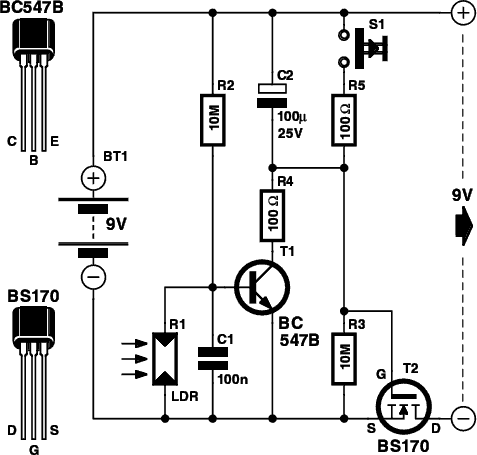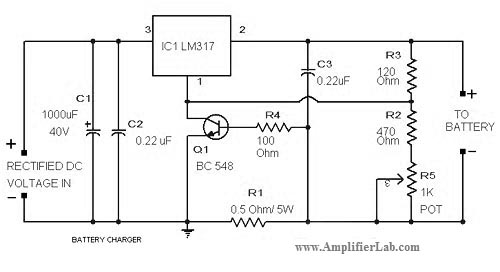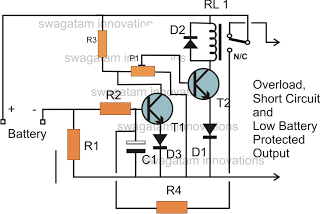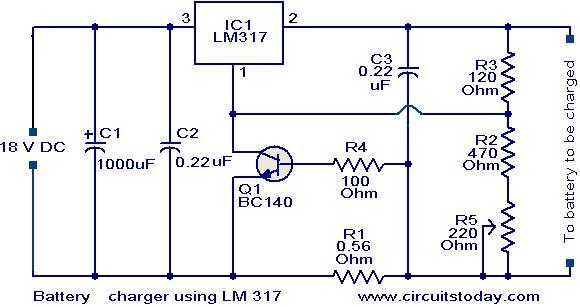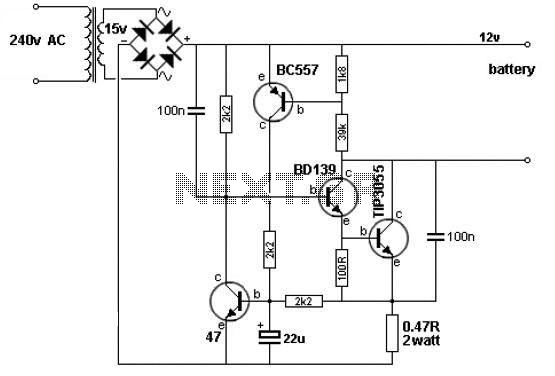
lead acid battery regulator for
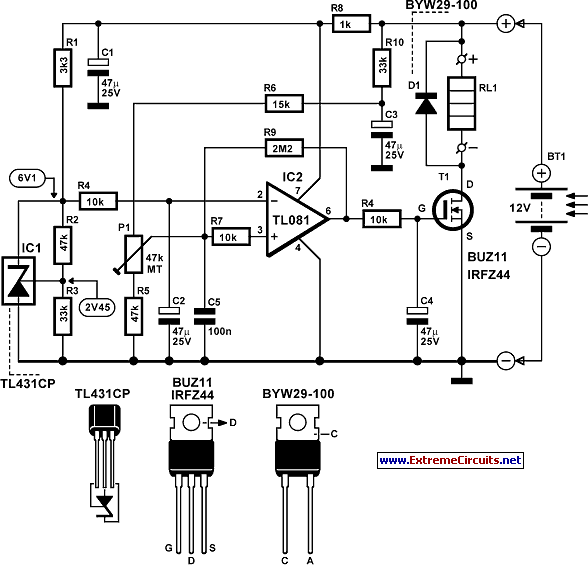
The design of solar panel systems with a lead-acid buffer battery typically allows for battery charging even during low sunlight conditions. However, this necessitates the use of a regulator to prevent overcharging during periods of abundant sunshine. Common solutions involve dissipating excess energy through a shunt resistor or short-circuiting the solar panels. This approach is inefficient, as it results in wasted energy from an otherwise costly system. The circuit described here redirects energy from the solar panel to alternative loads, such as a 12V ice box with Peltier elements, a water pump, or a 12V fan, once the battery is fully charged. It is also feasible to charge a secondary battery with the surplus energy, provided that there is a mechanism to divert excess energy when this second battery is also fully charged. The shunt resistor must be rated to handle the full power output of the solar panel; for example, a 100W panel would require a 100W shunt resistor, capable of handling approximately 6-8A at 12V. When the voltage falls below the maximum charging threshold of 14.4V due to decreasing sunlight, an n-channel power field effect transistor (FET), designated as T1, disconnects the shunt resistor. The disconnect point is stable against temperature variations due to a reference voltage supplied by IC1. The comparator IC2, with a small hysteresis voltage of 0.5V provided by R9, regulates the switching operation. Capacitor C5 facilitates a gradual switching process, mitigating the risk of electromagnetic interference from rapid voltage changes and limiting the inrush current for motors, such as those in fans. This gradual switching also helps to prevent significant switching losses in the FET, which could reach up to 25W, necessitating a heat sink. The circuit setup is straightforward; by adjusting potentiometer P1 to connect its wiper to R5, the output of comparator IC2 can be tuned to switch off when the battery voltage reaches between 13.8V and 14.4V. When the circuit is powered on for the first time, there is a brief delay of about two seconds for the electrolytic capacitors to charge, during which the comparator output remains high, momentarily activating the load across T1. For applications requiring low-resistance loads, the BUZ11 FET may be substituted with an IRF44, which has a higher power rating of 150W and a lower on-resistance of 24 mΩ. To protect against potential short-circuit conditions, it is advisable to incorporate a suitable fuse in the line to the regulator. The circuit operates with a quiescent current of only 2mA and draws no more than 10mA when T1 is activated.
The described solar panel system utilizes a sophisticated energy management approach to maximize efficiency and ensure safe operation. The primary components include the solar panels, the lead-acid buffer battery, the shunt resistor, and the control circuitry featuring transistors and comparators. The energy diversion mechanism is critical for optimizing the use of solar energy, allowing for real-time adjustments based on the battery's charge state. By integrating a secondary battery charging option, the system can further enhance energy utilization, making it suitable for various applications such as refrigeration, water pumping, and ventilation. The incorporation of hysteresis in the comparator design ensures stable operation, reducing the risk of oscillation and improving reliability. The gradual switching characteristics provided by the capacitors not only enhance performance but also contribute to the longevity of the components by minimizing thermal stress. Overall, this circuit design exemplifies a practical solution for efficient solar energy management, addressing common challenges associated with battery charging in solar applications.The design of solar panel systems with a (lead-acid) buffer battery is normally such that the battery is charged even when there is not much sunshine. This means, however, that when there is plenty of sunshine, a regulator is needed to prevent the battery from being overcharged.
Such controls usually arrange for the superfluous energy to be dissip ated in a shunt resistance or simply for the solar panels to be short-circuited. It is, of course, an unsatisfactory situation when the energy derived from a very expensive system can, after all, not be used to the full. The circuit presented diverts the energy from the solar panel when the battery is fully charged to another user, for instance, a 12V ice box with Peltier elements, a pump for drawing water from a rain butt, or a 12V ventilator.
It is, of course, also possible to arrange for a second battery to be charged by the super-fluous energy. In this case, however, care must be taken to ensure that when the second battery is also fully charged, there is also a control to divert the superfluous energy.
The shunt resistance needed to dissipate the superfluous energy must be capable of absorbing the total power of the panel, that is, in case of a 100W panel, its rating must be also 100 W. This means a current of some 6 8 A when the operating voltage is 12 V. When the voltage drops below the maximum charging voltage of 14. 4V growing to reduced sunshine, the shunt resistance is disconnected by an n-channel power field effect transistor (FET), T1.
The disconnect point is not affected by large temperature fluctuations because of a reference voltage provided by IC1. The necessary comparator is IC2, which owing to R9 has a small hysteresis voltage of 0. 5V. Capacitor C5 ensures a relatively slow switching process, although the FET is already reacting slowly owing to C4.
The gradual switching prevents spurious radiation caused by steep edges of the switched voltage and also limits the starting current of a motor (of a possible ventilator). Finally, it prevents switching losses in the FET that might reach 25W, which would m a ke a heat sink unavoidable.
Setting up of the circuit is fairly simple. Start by turning P1 so that its wiper is connected to R5. When the battery reaches the voltage at which it will be switched off, that is, 13. 8 14. 4V, adjust P1 slowly until the output of comparator I C2 changes from low to high, which causes the load across T1 to be switched in. Potentiometer P1 is best a 10-turn model. When the control is switched on for the first time, it takes about 2 seconds for the electrolytic capacitors to be charged.
During this time, the output of the comparator is high, so that the load across T1 is briefly switched in. In case T1 has to switch in low-resistance loads, the BUZ11 may be replaced by an IRF44, which can handle twice as much power (150 W) and has an on-resistance of only 24 mR.
Because of the very high currents if the battery were short-circuited, it is advisable to insert a suitable fuse in the line to the regulator. The circuit draws a current of only 2 mA in the quiescent state and not more than 10mA when T1 is on.
🔗 External reference
The described solar panel system utilizes a sophisticated energy management approach to maximize efficiency and ensure safe operation. The primary components include the solar panels, the lead-acid buffer battery, the shunt resistor, and the control circuitry featuring transistors and comparators. The energy diversion mechanism is critical for optimizing the use of solar energy, allowing for real-time adjustments based on the battery's charge state. By integrating a secondary battery charging option, the system can further enhance energy utilization, making it suitable for various applications such as refrigeration, water pumping, and ventilation. The incorporation of hysteresis in the comparator design ensures stable operation, reducing the risk of oscillation and improving reliability. The gradual switching characteristics provided by the capacitors not only enhance performance but also contribute to the longevity of the components by minimizing thermal stress. Overall, this circuit design exemplifies a practical solution for efficient solar energy management, addressing common challenges associated with battery charging in solar applications.The design of solar panel systems with a (lead-acid) buffer battery is normally such that the battery is charged even when there is not much sunshine. This means, however, that when there is plenty of sunshine, a regulator is needed to prevent the battery from being overcharged.
Such controls usually arrange for the superfluous energy to be dissip ated in a shunt resistance or simply for the solar panels to be short-circuited. It is, of course, an unsatisfactory situation when the energy derived from a very expensive system can, after all, not be used to the full. The circuit presented diverts the energy from the solar panel when the battery is fully charged to another user, for instance, a 12V ice box with Peltier elements, a pump for drawing water from a rain butt, or a 12V ventilator.
It is, of course, also possible to arrange for a second battery to be charged by the super-fluous energy. In this case, however, care must be taken to ensure that when the second battery is also fully charged, there is also a control to divert the superfluous energy.
The shunt resistance needed to dissipate the superfluous energy must be capable of absorbing the total power of the panel, that is, in case of a 100W panel, its rating must be also 100 W. This means a current of some 6 8 A when the operating voltage is 12 V. When the voltage drops below the maximum charging voltage of 14. 4V growing to reduced sunshine, the shunt resistance is disconnected by an n-channel power field effect transistor (FET), T1.
The disconnect point is not affected by large temperature fluctuations because of a reference voltage provided by IC1. The necessary comparator is IC2, which owing to R9 has a small hysteresis voltage of 0. 5V. Capacitor C5 ensures a relatively slow switching process, although the FET is already reacting slowly owing to C4.
The gradual switching prevents spurious radiation caused by steep edges of the switched voltage and also limits the starting current of a motor (of a possible ventilator). Finally, it prevents switching losses in the FET that might reach 25W, which would m a ke a heat sink unavoidable.
Setting up of the circuit is fairly simple. Start by turning P1 so that its wiper is connected to R5. When the battery reaches the voltage at which it will be switched off, that is, 13. 8 14. 4V, adjust P1 slowly until the output of comparator I C2 changes from low to high, which causes the load across T1 to be switched in. Potentiometer P1 is best a 10-turn model. When the control is switched on for the first time, it takes about 2 seconds for the electrolytic capacitors to be charged.
During this time, the output of the comparator is high, so that the load across T1 is briefly switched in. In case T1 has to switch in low-resistance loads, the BUZ11 may be replaced by an IRF44, which can handle twice as much power (150 W) and has an on-resistance of only 24 mR.
Because of the very high currents if the battery were short-circuited, it is advisable to insert a suitable fuse in the line to the regulator. The circuit draws a current of only 2 mA in the quiescent state and not more than 10mA when T1 is on.
🔗 External reference

